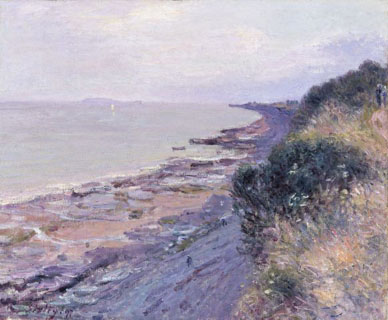“Sisley in England and Wales”, a small exhibition in the National Gallery’s Sunley Room, tells a quietly affecting story of art, love and death. Its subject, compressed to a display of seventeen pictures, is the work created by the leading French Impressionist, Alfred Sisley, during his two painting campaigns in England and Wales. The first trip, in the summer and autumn of 1874, produced a memorably dislocated series of pictures of London and Hampton Court. The second journey, undertaken twenty years later, took Sisley to Cornwall and then to Gower, in Wales, resulting in the artist’s only sustained group of marine pictures.
Alfred Sisley (1839-1899) had strong links with England. He was born in France, to English parents, and sent to London at the age of eighteen to study commerce. His father, a successful businessman, had hopes that the young man would follow in his own footsteps. But Sisley preferred to spend his time in the National Gallery, and on his return to Paris he enrolled in the studio of Charles Gleyre, where he became close friends with a number of painters of his own age, including Claude Monet and Pierre-Auguste Renoir. Over the next decade and more, the young artists forged a new approach to painting. In 1874, they held the first independent exhibition of their works. The term “Impressionism” – originally intended as an insult – was coined as a description of their style.
It was in the summer of that year that Sisley returned to London. At first he painted the capital itself, depicting paddle steamers swarming up the smoggy Thames towards Charing Cross Bridge, and registering the venerable silhouette of St Paul’s as little more than a distant smudge in a murky sky. But he soon decided that he preferred the western suburbs, in particular...


